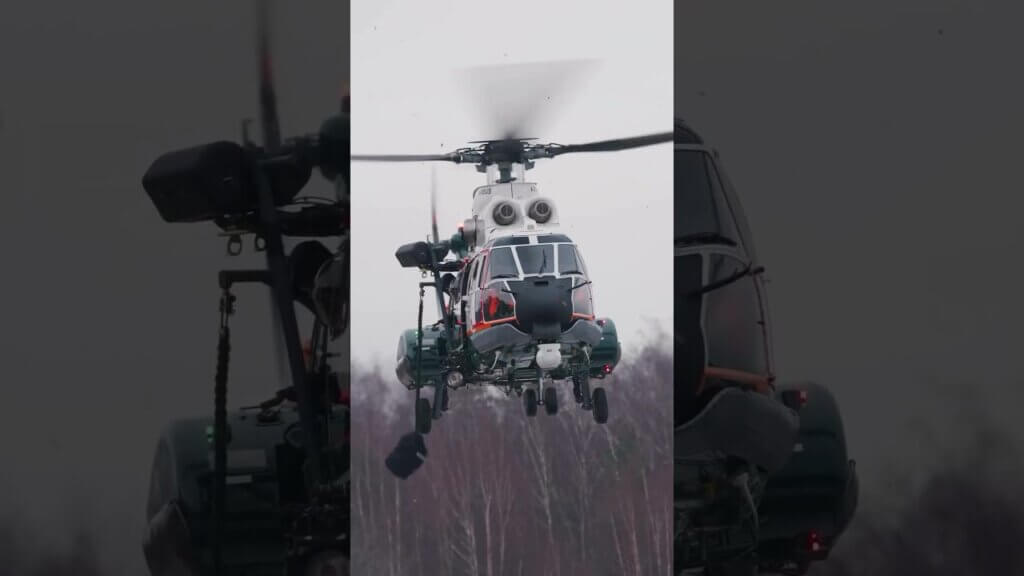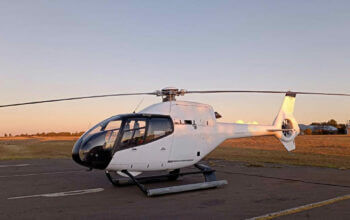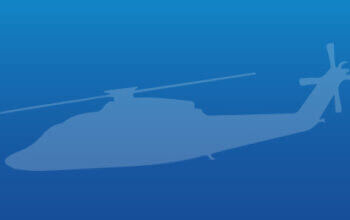Airbus Helicopters will begin taking letters of intent for the H160 as HAI Heli-Expo 2016 gets underway in Louisville, Ky., today, as the manufacturer officially begins the aircraft’s commercialization phase.
The new 5.5- to 6-tonne aircraft has seen rapid development since it was unveiled as the result of Airbus Helicopters’ X4 program at Heli-Expo 2015 in March last year. The first prototype (PT1) was assembled in just nine months and performed its first flight on June 13, 2015, and was followed in flight by the second prototype (PT2) on Jan. 27, 2016. The first flight of PT2 also marked the first flight of the 1,200-shaft-horsepower Turbomeca Arrano engines in an H160 (the Arrano is the engine that will be used in the production version of the aircraft), and as Heli-Expo opened its doors, the two prototypes had accumulated a total of over 100 flight hours.
“We’ll [now] start to talk with customers and we are willing to sign letters of intent with them and enter into a process of negotiation in order to sign contracts in a few months,” said Bernard Fujarski, head of the H160 program, at a press briefing ahead of the show. “We believe that we now have the maturity to be able to do that. Before you take commitment, you have to know exactly what you are able to do. And we will know that regarding the performance of the helicopter in a few months from now.”
Fujarski pointed to the two “Helicopter Zero” test bench aircraft, created at Airbus Helicopters’ facility in Marignane, France, as one of the reasons the program has matured so quickly. “System Helicopter Zero” houses the aircraft’s electrical equipment and harnesses, together with the H160 cockpit, to refine and ensure the functionality of the electrical systems; “Dynamic Helicopter Zero” contains the H160’s engines, transmission, rotors and tail boom.
“Each month [on previous programs] we used to fly about 10 to 12 hours, [and] we are flying now 20 percent more because we have been able to test and mature the definition and design on our Helicopter Zeros,” he said.

The new 5.5- to 6-tonne aircraft has seen rapid development since it was unveiled as the result of Airbus Helicopters’ X4 program at Heli-Expo 2015 in March last year. Anthony Pecchi Photo
Flight tests have seen the H160’s flight envelope gradually expanded, with the aircraft recording a max speed of 182 knots — 12 knots higher than its planned never exceed speed of 170 knots. While hesitant to provide too much detail of the pilot feedback, Fujarski praised the aircraft’s aerodynamic behavior and handling qualities.
“We performed most of the first 20 hours of flight without the autopilot, and it was very easy for the crew to control the helicopter,” he said. “There is a sort of natural decoupling between the axis, which is extremely good.”
Aiding that control is one of the aircraft’s most striking design features — its 12-degree tilted Fenestron. “The tail rotor is working a little bit better than expected,” said Fujarski. “In fact, it’s asking for less power for the same efficiency than predicted by the simulation.”
Without having completed official performance tests for the Arrano-powered PT2, Fujarski declined to compare its performance to the PW210E-powered PT1, but said that the data would be available within the next few weeks. “On the bench . . . the [Arrano] engine is 100 percent compliant to the specification,” he said. “But we don’t have the final data yet. The feeling is good, but we don’t have a measurement, and we haven’t performed all the flight tests according to the specifications.”

Flight tests have seen the H160’s flight envelope gradually expanded, with the aircraft recording a max speed of 182 knots — 12 knots higher than its planned never exceed speed of 170 knots. Anthony Pecchi Photo
So far, the most significant modification from the first two prototypes to the likely production aircraft will be to address a slight nose-up attitude in the hover. To correct this, the H160’s electrical master boxes will be moved from the rear of the aircraft to the nose — beginning with the third prototype aircraft (PT3), which is set to join the testing fleet at the start of 2017.
Maturing the Design
In tandem with the development of the aircraft, Airbus Helicopters has been designing the manufacturing program to be employed for the full-scale production of the H160. For the serial aircraft, the manufacturer will use a “major component assembly” model, whereby five modules (tail boom, central fuselage, front fuselage, main dynamic components, and blades) are fully built and tested in parallel, then shipped to the H160’s final assembly line (FAL) in Marignane. The aim is to reduce the lead time on the assembly line from the Dauphin’s 36 weeks, to 18 weeks with the H160.
For now, Airbus Helicopters is beginning to validate the industrial model using a digital mockup and through the first pre-serial helicopter (of a total of five or six), which, for some equipment, will be created using a method borrowed from the automotive industry called “the ring.”
“Let’s take, for instance, the example of flight controls,” said Fujarski, explaining the concept. “The day we will install flight controls within the [first pre-serial] helicopter, we will have the designer of flight controls together with the guy in charge of fitting flight controls, plus a member of quality. Together they will be protected by a physical ring, [so] nobody is interfering with what they are doing, and the guy in charge of assembly will try to apply the procedure. If it does match, it is ok. If there’s a problem with the procedure, it is corrected live. If it is a problem with the design, the designer is there, and eventually the supplier is there as well to take into account the correction and implement it very rapidly.”
The first station on the FAL is set to be delivered by the end of the year. Currently, the plan is for the H160 FAL to use the building currently occupied by the Dauphin FAL. However, Fujarski said a timeline hasn’t been set for H155 production to stop. “It depends on the market and the ability of the Dauphin program still to capture sales and our ability also to ramp up as predicted,” he said. “We have a plan, but it will be probably adjusted depending on the environment and the circumstances.”

The H160 will be produced in one of several “favorite configurations,” similar to the existing manufacturing process for the H135, H145, and H175. Anthony Pecchi Photo
Work is due to begin on the first production H160 early next year. The assembly line will begin as a flow line with limited speed, said Fujarski, before pushing to a full production rate of 50 helicopters per year around aircraft number 12 or 13.
Finally, in order to have a fully mature product at entry-into-service, Airbus Helicopters has been working on the H160’s maintenance support and services. This has included the selection of Helisim and Thales for the design and manufacture of an H160 full flight simulator, and the creation of digital maintenance documentation and a digital flight manual to support the target of creating a paperless aircraft.
Upcoming Developments
Looking ahead, PT1 will soon take a break from flight-testing to be re-engined with the Arrano. (It is currently fitted with the Pratt & Whitney Canada PW210E — which was originally planned to be one of two engines offered with the aircraft, before Airbus Helicopters decided to continue development with the Arrano alone.) PT1 and PT2 will then be joined by PT3 — the final prototype H160 — at the beginning of 2017. Those three aircraft, together with the two Helicopter Zero test bench aircraft, will take the program’s development through to certification and first delivery.
The H160 will be produced in one of several “favorite configurations,” similar to the existing manufacturing process for the H135, H145, and H175. As things stand, the “transport” configuration — which covers both oil-and-gas and emergency medical services missions — will be the first configuration offered when the aircraft is certified in 2018. A year later, a VIP version will be available, followed by a public service configuration a year after that.
“We are using the coming months, starting at HAI [Heli-Expo] until the summertime, to really assess the market and see if that order is still the right one,” said Fujarski. “We’ll be able, if necessary, to readjust the sequence in the summertime.”
A military version of the aircraft has not yet been launched, but Fujarski said the manufacturer has entered discussions with the French ministry of defense about offering a H160M to meet the requirements of its upcoming hélicoptère interarmées léger (HIL) program. The acquisition process for the HIL program, which would replace hundreds of light and medium helicopters operated by all three branches of the French military, is expected to begin in 2020.
Fujarski said the H160 had already generated a huge amount of interest since its debut last year. “The attractiveness of the aircraft has gone far beyond our expectations,” he said. “It was confirmed as well during the Paris Air Show and Dubai Airshow where we got a lot of feedback — and especially from the VIP market, where it was less expected.”
While the H160 will not be making a physical appearance at this year’s Heli-Expo, visitors will have the opportunity to explore it through a brand new, interactive virtual reality presentation.









